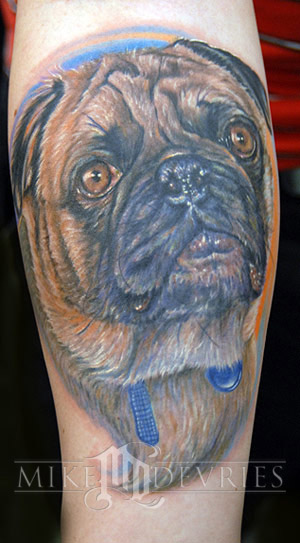
At a waterpark last summer, I counted a dozen suburban moms with tattoos dotting their ankles, necks and lower backs. It was, for me, a watershed tally. What I’d been reading in trend stories for years finally sank in: Tattooing is mainstream.
According to tattoo artists I’ve talked to since, average Joes and Janes have been going under the needle for decades, but popular TV reality shows such as Miami Ink have revved the phenomena like a Harley engine. Some estimates put the number of tattooed Americans at one in seven. A Pew Research Center poll released last year revealed that four in 10 Gen Xers sport at least one tatt and 36 percent of all Gen Nexters (the oldest of whom just turned 26) have begun blazing a body-art trail that should put them on track to eclipse their elders.
So, when a nearly photographic likeness of a Pug permanently inked into DeAnna Miller’s arm arrived in my inbox—apropos of nothing and shortly after my waterpark revelation—it seemed natural to wonder: Where exactly are our dogs in all of this?
 A few strategically sent emails to tattoo-savvy associates revealed a simple truth: Roll up the pant leg or draw back the sleeve of a tattoo-loving dog person and you’re likely to discover everything from Kanji-script dog names to painterly canine portraits.
A few strategically sent emails to tattoo-savvy associates revealed a simple truth: Roll up the pant leg or draw back the sleeve of a tattoo-loving dog person and you’re likely to discover everything from Kanji-script dog names to painterly canine portraits.
“It’s relatively new,” says C.W. (Chuck) Eldridge, a tattooist who researches and documents tattoo history and is the owner of the Tattoo Archive in Winston-Salem, North Carolina. “Dog portraits in the past weren’t really popular. Now it’s actually quite common. Not just dogs, but cats, snakes and birds. You name it. You know how people love their pets.”
Kelly McGuire was a tattoo-free zone (a “virgin” in parlor parlance), when she entered a Topeka tattoo shop seven years ago, soon after the unexpected death of Geisha, her five-year-old Pug. Geisha was the first dog of McGuire’s to die, and the loss was devastating. “It killed me. I cried every day,” she says. With her husband’s encouragement, McGuire got a tattoo of Geisha’s face on her arm. “All of a sudden, it felt like a weight was lifted off me. I felt so much better.”
Though McGuire tells me that she thinks her story sounds weird, she’s neither weird nor unique. Several people, including a woman who added a smidge of her late dogs’ ashes to her tattoo ink, described tremendous grief relief after getting a memorial tattoo.
 The mere idea of her dog’s mortality drove Janet Beeby, a canine massage practitioner and avid agility competitor, to a tattoo shop. “As she was getting older, I was starting to get very panicked,” Beeby says about her 10-year-old Kerry Blue Terrier, Gabby. “She’s been an amazing partner to me.”
The mere idea of her dog’s mortality drove Janet Beeby, a canine massage practitioner and avid agility competitor, to a tattoo shop. “As she was getting older, I was starting to get very panicked,” Beeby says about her 10-year-old Kerry Blue Terrier, Gabby. “She’s been an amazing partner to me.”
Gabby—the first Kerry Blue to earn a master’s agility champion title—inspired a rock star design. In the tattoo, she leaps through a bright red collar (her signature “jewelry”) on Beeby’s thigh. “The idea was, I’ll have Gabby on my lap for the rest of my life,” Beeby says. It’s a portrait, but in a bold, illustration-style. “My non-doggy friends are like, ‘I guess you’re the only one with that tattoo,’” Beeby says. “My doggy friends are like, ‘that’s hot!’”
DeAnna Miller, whose Pugsley Ann portrait inspired my tattoo odyssey, says, “Believe it or not, there are quite a few people who want to pet my arm.”
Probably the best-known dog in American tattoo history is the United States Marine Corps bulldog. When World War I German fighters referred to the Marines as “Devil Dogs,” a smart flack at the Corps created a recruiting poster featuring an English Bulldog running down an Iron Cross–wearing Dachshund. Just as actual Bulldogs were adopted as mascots, jowly Devil Dogs in helmets turned up on Marine biceps everywhere.
There are countless dog lovers out there, but few go to the extreme of getting dog tattoos to express this devotion to their loyal friends. These dog lovers have justified reasons to be so fanatical about their pets. Dogs are loving, loyal, and trustworthy creatures. They tend to put a smile on faces that don’t always remember how that is done.Everybody knows the cliché “a dog is a man’s best friend.” The symbolism behind this statement is remarkable. Dogs will go to extremes to protect their masters and friends. Although they are low on the totem pole amongst the animals, they are the most common household pet among us humans because of their domestic and friendly disposition. Dogs tend to offer protection in the name of their owners and families against anything they instinctively sense to be threatening.





